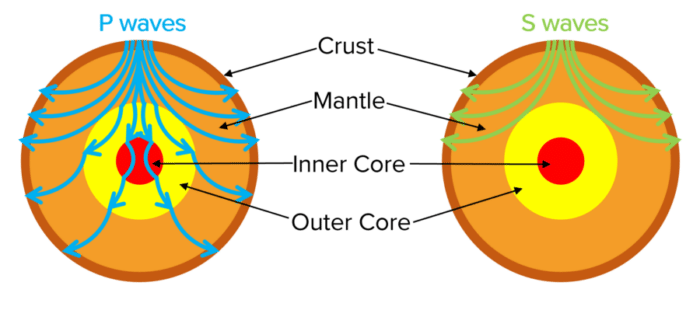Seismic Waves
Seismic Waves Revision
Seismic Waves
Seismic waves are produced by earthquakes and volcanic eruptions. Scientists have used the properties of seismic waves to determine the internal structure of the Earth.
Measuring Seismic Waves
If an earthquake or volcanic eruption occurs, seismic waves are produced. These waves travel through the Earth and can be detected by instruments called seismometers.
Scientists can use seismic waves to study the inner structure of the Earth. They measure:
- The time it takes for the seismic waves to reach different points on the surface of the Earth.
- Which places the seismic waves don’t reach.
If the wave does not reach a location, it must have been reflected or refracted by a boundary between different types of material.
There are two types of seismic waves:
P waves – these are longitudinal waves that travel at different speeds through solids and liquids.
S waves – these are transverse waves that cannot travel through liquids.
The Internal Structure of the Earth
Because P waves and S waves have different properties, we can detect their paths after an earthquake or volcanic eruption to determine the inner structure of the Earth.
The main layers in the Earth are:
- Crust – solid
- Mantle – almost solid
- Outer Core – liquid
- Inner Core – solid
P waves are refracted at the boundaries between different layers in the Earth. S waves only travel through the crust and the mantle. This means that P waves reach more distant locations.

Seismic Waves Example Questions
Question 1: Name two geological events that may produce seismic waves?
[2 marks]
- Earthquakes
- Volcanic Eruptions
Question 2: Discuss the similarities and differences in the properties between P waves and S waves.
[2 marks]
Any two from:
- P waves are longitudinal whereas S waves are transverse.
- Both P waves and S waves can travel through solids.
- P waves are refracted at boundaries with liquids but S waves cannot travel through liquids.
- Both P waves and S waves are produced by earthquakes and volcanic eruptions (both are seismic waves).
Question 3: Explain how P waves and S waves can be used as evidence for the internal structure of the Earth.
[6 marks]
After an earthquake or volcanic eruption, P waves and S waves can be measured at different locations using a seismometer.
P waves and S waves are refracted and reflected at boundaries between different layers in the earth.
By finding the locations where P and S waves are and are not present, we find that the Earth must have liquid layer (the mantle) a solid core, through which S waves cannot travel.







